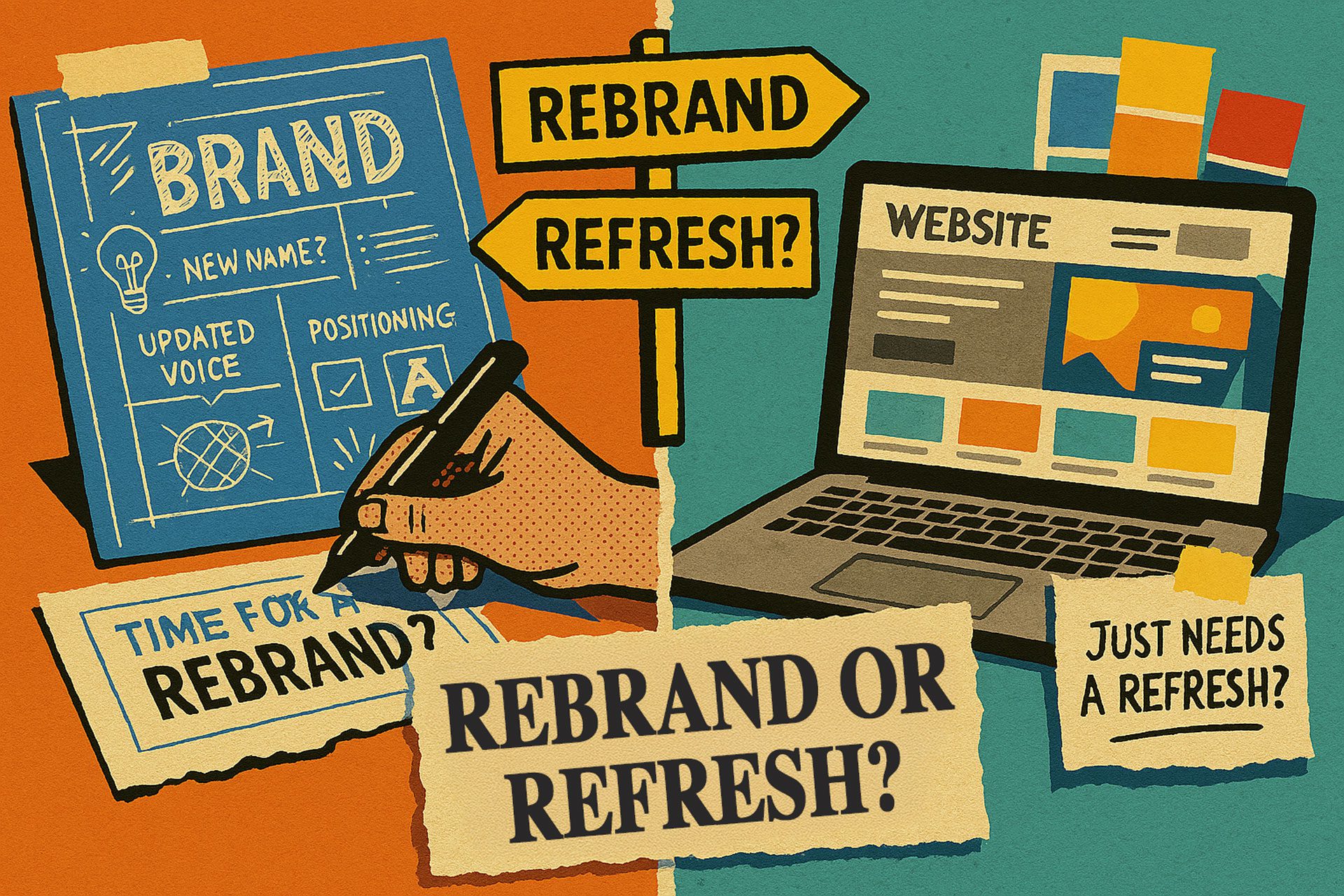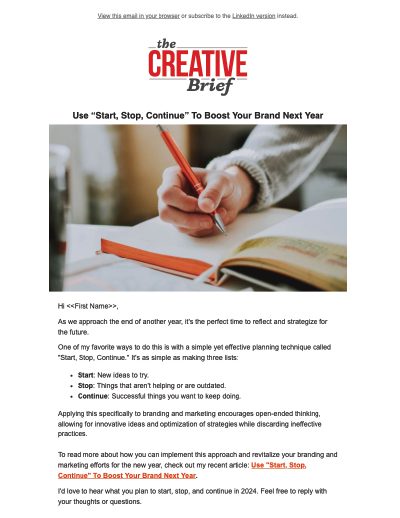No business can afford to rest on its laurels. While your company may be keeping up with economic and market changes, is your brand keeping up? Does your website communicate to your target audience how you’re keeping up?
You may be deciding whether to rebrand your business or update your website. Here are 10 factors to consider to help you make your decision.
When Should You Consider A Rebrand?
Rebranding is a standard business strategy and has been for many years. We usually only notice branding changes as consumers if they’re serious makeovers. Most are subtle visual transformations – think of color changes to a sports team’s logo or uniforms or packaging design updates.
Changing a logo or the font of your company’s name on business cards might not be a huge deal. Still, rebranding can be a significant public declaration of intent, a marker of your company’s commitment to evolution and upward growth.
Other times, rebranding can represent a more substantial effort to shift the consumers’ perception of a brand or show a company’s progress in an evolving market. It may be time for your company to consider a rebrand too.
Here are 5 reasons why:
1. Your business model or strategy has changed
Sometimes the strategic objectives on which a company is founded are different from the same goals five years later. Whether it’s unforeseen market opportunities or technological changes, business models change. And when your business changes, so must your brand.
How your company is perceived by those it serves (i.e., your brand) should always align with how it operates behind the scenes.
2. You’re struggling to raise your prices
Suppose the market price for your products or services seems hopelessly fixed, despite the rising materials costs. In that case, there may be something you can do about it. Because brands ultimately boil down to customer perception, the value of your offerings is entrenched in the minds of those you serve.
By rebranding, you can reshape how your customers perceive you and raise the asking price of your services accordingly.
3. You’re trying to connect with a new audience
Today it’s millennials. Tomorrow it’ll be the iGen (AKA Generation Z). However silly the moniker, there’s always another generation hot on the heels of those who are spending money in the current marketplace. A rebrand allows you to reposition yourself to reach these new and untapped audiences. Staying on top of demographic shifts is good business.
After all, the last thing a savvy young demographic wants is to associate itself with the stodgy brands of their parent’s generation.
4. You’re not attracting top talent
The best talent wants to work for the best brands. It’s as simple as that. Suppose you’re having difficulty recruiting the caliber of employees necessary for your business’s advancement. In that case, it might be because your reputation (your brand) is associated with negative connotations.
A rebrand allows you to redefine yourself, not just for your customers but for your current and future employees.
5. You’re embarrassed to hand out your business card or website address
Do you cringe when you reach for your card or feel like your website should have a disclaimer about needing to be updated? Outdated, stale, boring, unoriginal—if your corporate identity or online presence falls under one or more of these descriptions, it’s time to rebrand.
Rebranding can catapult your business to new heights of success.
Whether they’re plain as day or hiding in plain sight, signs that it’s time to rebrand can be just about anywhere. Often the first sign is that you’re wondering if a rebrand is necessary! Whatever eventually compels you to reach out to a branding firm, you can rest assured you’re making the right decision. With the number of measurable benefits of rebranding, the investment is likely to pay off many times over.
When should you redo your website?
Every business needs an effective website. It is the hub of all of your online marketing activities. With an effective website, you will see significant results from any online advertising campaign.
You are potentially losing money if your website is old, doesn’t communicate your value to potential customers, and isn’t designed well.
Here are 5 reasons why:
1. Your website design is not generating revenue, sales, leads, or worse: it has a high bounce rate.
If your website receives traffic but no conversions, this is a problem. Your website could be missing something critical that is turning your website, visitors, off.
Bounce rate is the percentage of visitors to a website who navigate away from the site after viewing only one page. In other words, people exit your website as soon as they enter it. Your goal should be to have the lowest bounce rate possible. Low bounce rates indicate that visitors find your website to be valuable. Therefore, the lower your bounce rate, the more opportunities you have to increase sales.
2. Your website design is outdated or does not make a good first impression
First impressions are everything. You only have 3 seconds to make an impression on a website visitor. You will likely miss opportunities if your website does not make a good impression within this time frame.
Suppose you have not worked on your website since the Obama administration, or you have a new website that looks like a website made in those times. In that case, it’s time for a redesign.
Your website is never finished. Make gradual improvements to your website design over the years to keep up with the times. As time progresses, consumer tastes and preferences change. If your website design is outdated and does not make a good impression, prepare for the exit button.
3. You rarely get positive feedback on your website
You may be getting leads and generating sales, but have you ever surveyed your customers to inquire about their experience with your website? If not, you may be missing opportunities to increase your conversion rate or to influence your brand’s perceived value.
One change on your website may increase your sales or your reputation. If you never get positive feedback on your website, ask for it. Survey your customers, or ask a friend, to give you feedback on your website. There may be fundamental design changes you can make to increase your bottom line.
4. Your website is hard to understand
It makes sense to you but no one else. You used fancy words or jargon that potential customers need help understanding. The images on the website do not correspond with the message you want to portray. The font types are inconsistent, and the font sizes do not follow best practices. Get the point?
A professionally produced website will get this right the first time. Avoid spending unnecessary time and energy on a website that you will completely overhaul in the future.
5. You are always thinking about changing your website
As soon as you tell someone your website URL, you say, “don’t judge it; we’re still working on it.” While you really don’t want people to judge your website, you are not really working on it.
With the right website design, you do not have to be insecure. You will be confident in your website’s ability to effectively communicate your message to your visitors. You will trust your conversion funnel and feel more comfortable investing in advertising services.
Redoing your website can take your business to the next level.
When considering what your website can do for you, think of it as if it was a sore. Your visitors will walk in and make purchasing decisions based on how it looks and speaks to them.
If your customers walk in and don’t feel like they are in the right place, they will have a poor experience, and they probably won’t feel compelled to buy from you.
Is your brand holding you back?
If you’re like many businesses, you’ve invested time and money in marketing that isn’t working—and that’s frustrating. Before you spend another dollar on ads or redesigns, find out if your brand is the real issue. Download the free 15-Minute Brand Checkup worksheet to assess where your brand stands and what might be holding your marketing back.




